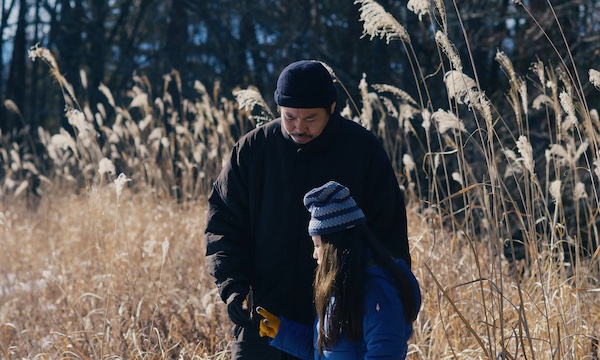Film Review: “Evil Does Not Exist” — Goodness on Trial
By Peter Keough
This is a lucid but dreamlike fable about the often fraught confrontation between humanity and nature.
Evil Does Not Exist. Directed and written by Ryusuke Hamaguchi. At the AMC Boston Common 19.

Hitoshi Omika and Ryo Nishikawa in a scene from Evil Does Not Exist. Photo: Sideshow/Janus Films
For the first five minutes or so Ryusuke Hamaguchi’s Evil Does Not Exist has its head in the clouds. The camera gazes upward through the trees, ambling through a primeval forest near Mizubiki, a rustic village not far from Tokyo, while Eiko Ishibashi’s ethereal, oddly ominous music plays on the soundtrack. A cut is made to a little girl — was she the one gazing? Then to a man with a chainsaw cutting logs into firewood, nature demoted from object of wonder to source of fuel. And who is looking at him?
These are just the first of the mysteries in this lucid but dreamlike fable about the often fraught confrontation between humanity and nature — not to mention the elusiveness of point of view, of memory, of chronology, and of perception itself. The man, we learn, is Takumi (Hitoshi Omika), a widower, and the girl is his daughter Hana (Ryo Nishikawa). Takumi is like a more domesticated Hirayama, the protagonist of Wim Wenders’s Perfect Days, relocated from the city to the country but still satisfied with an unambitious, socially responsible routine. Like filling bottles with spring water to be used by the local noodle restaurant, a chore that delays him in picking up his daughter at school, one of the film’s handful of Chekhovian loaded guns.
The only disruption in this idyll are the occasional gunshots heard in the distance, the carcass of a fawn found along the trail, and the developers who are planning to establish a site for “glamping” (short for “glamour camping”), where tourists can rough it in nature but with luxury accommodations. Representatives for the new resort — Mayuzumi (Ayaka Shibutani), a young woman new to the PR business and more sympathetic to the locals, and Takahashi (Ryuji Kosaka), an older pro, who is more confrontational — hold a community meeting to reassure people that the encampment will not spoil their habitat.
In a reflexive wrinkle, the firm promoting the glamp is a talent agency called “Playmode” and Takahashi himself is a former actor, recalling the protagonist of Hamaguchi’s Oscar-winning Drive My Car (2021). The spuriousness of such an artificial outfit posing as environmental experts does not go unnoticed by those attending the meeting during their thorough takedown of the project.
The phoniness of the representatives is the least of the locals’ reservations. Is the septic tank adequate for the site? Won’t the waste run downhill into the water table? Will glampers break the rules and build bonfires, threatening a conflagration in the dry season à la Christian Petzold’s Afire? Shouldn’t there be a caretaker on hand 24 hours a day? And Takumi informs them that they will have to build a fence to keep out the deer. These creatures may seem timid and avoid humans, but if they are wounded and backed into a corner or must protect their young, they will attack. The two city slickers are overwhelmed by the objections and hostility of the crowd and they fumble to respond. Yet though stung, they — or at least Mayuzumi — seem to be warming to the villagers’ outlook.
Hamaguchi then switches point of view and visits Tokyo, where Mayuzumi and Takahashi and their boss confer via Zoom with the glamping client. Maybe they might delay the project, suggests Mayuzumi, until they can respond to the community’s concerns? Instead the client cynically instructs them to return to the village and entice Takumi into collaborating with them by offering him a bottle and the job of caretaker. They do so and find him again chopping wood, and though he declines the bottle (is he a recovering alcoholic?) he shows a willingness to listen to their proposals.
Out of genuine impulse, or canny manipulativeness, or both, Takahashi asks to take a hand with the axe. After a couple of flubs and some instruction from Takumi he hits the log’s sweet spot and splits it cleanly. “That felt great!” he shouts. Perhaps he might take the job of caretaker himself, and Takumi can be his adviser…
Or perhaps not. A denouement follows that dramatizes a deeper entanglement of the knotty ambiguities and conflicts raised throughout the film, a catastrophe in which past and present, reality and illusion, and memory and desire merge into a lingering enigma. What remains clear is the finality of loss and the inadequacy of consolation. The mood recalls the concluding speech from Uncle Vanya as performed in Drive My Car: “We shall hear the angels, we shall see the whole sky all in diamonds, we shall see how all earthly evil, all our sufferings, are drowned in the mercy that will fill the whole world.” But here there is no evil, or angels, or mercy. Only the suffering remains.
Peter Keough writes about film and other topics and has contributed to numerous publications. He had been the film editor of the Boston Phoenix from 1989 to its demise in 2013 and has edited three books on film, most recently For Kids of All Ages: The National Society of Film Critics on Children’s Movies (Rowman & Littlefield, 2019).

